What We Are Seeing Buyers Responding to in Q1 2025
Southern California has always been a hub for forward-thinking home design, where innovation meets lifestyle, and every detail enhances the way we live. At The Klapper Group, we believe homes should be more than just structures—they should be sanctuaries that reflect personal style, promote well-being, and offer smart, sustainable living. As we move through the first quarter of 2025, these trends are shaping the future of residential design across our vibrant communities.
1. Earthy Tones and Warm Color Palettes
The sterile grays of the past are fading, replaced by rich, earthy hues like cocoa brown, olive green, rust, and terracotta. These shades bring warmth and depth, creating inviting spaces that feel both modern and timeless. Home should feel like home—comforting, personal, and designed for everyday living.
Adding to this warm aesthetic, Pantone’s Color of the Year for 2025, Mocha Mousse (PANTONE 17-1230), is setting the tone for interiors. This rich, sophisticated brown evokes feelings of comfort and indulgence, making it a natural fit for statement walls, cabinetry, or even plush furnishings. Imagine a sleek Mocha Mousse accent wall in a modern living room, complemented by soft, neutral decor—it’s an effortless way to stay on-trend while maintaining a timeless appeal.
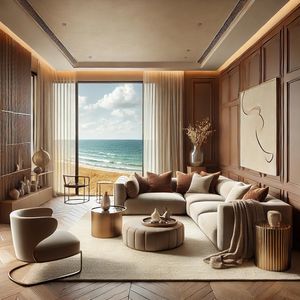 Pantone color of the year for 2025 – 17-1230, Mocha Mousse
Pantone color of the year for 2025 – 17-1230, Mocha Mousse
2. Curved and Organic Forms
Mid-century design remains HOT in today’s market, influencing everything from architectural elements to furniture choices. Rigid lines are softening as curves take center stage in interiors, creating a sense of ease and movement. Arched doorways, rounded edges, and sculptural seating aren’t just visually appealing; they make homes feel more welcoming and dynamic. Inspired by mid-century modern influences and Mediterranean-style homes, curved staircases, statement-arched bookcases, and waterfall-edge countertops are becoming signature design elements in luxury properties. In the fast-paced world we live in, a home designed for comfort and connection is essential.
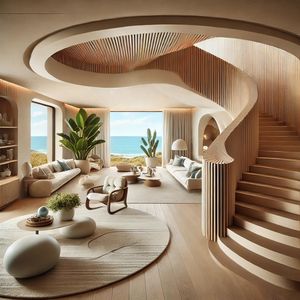 An example of how curved lines can blend in luxury spaces.
An example of how curved lines can blend in luxury spaces.
3. Sustainability and Fire-Resistant Materials
Eco-conscious living isn’t a trend—it’s a responsibility. Given Southern California’s unique climate and ecological considerations, homeowners are prioritizing fire-resistant materials like adobe and cob, while embracing passive solar designs for energy efficiency. At The Klapper Group, we emphasize homes that are as resilient as they are beautiful, helping our clients invest in smart, sustainable living solutions.
Fire hardening is becoming a crucial part of home design in high-risk areas. Some key fire-resistant upgrades include:
- Fire-Resistant Roofing – Class A fire-rated roofing materials like metal, slate, and clay tiles provide better protection than traditional asphalt shingles. Ask about Class A fire-rated options like Boral Steel Roofing and GAF Timberline HDZ Shingles
- Ember-Resistant Vents – Fine mesh screens and specially designed vents help prevent embers from entering attics and crawl spaces. Vulcan Vents and Brandguard Vents are two reliable brands.
- Non-Combustible Siding – Fiber cement, stucco, and treated wood are increasingly being used for exterior walls to minimize fire spread. Look for fiber cement siding from James Hardie HardiePlank and LP SmartSide Trim & Siding
- Dual-Pane Tempered Glass Windows – These offer better resistance to heat and can reduce the likelihood of breakage during a wildfire. Check into Milgard Ultra Series Fiberglass Windows and Pella Lifestyle Series Windows.
- Defensible Space Landscaping – Creating buffer zones around a home with non-flammable plants, gravel pathways, and proper tree spacing helps slow fire spread and protects structures. A couple of things to consider:
- Fire-Resistant Mulch – Gravel, decomposed granite, or Class A fire-rated rubber mulch
- Fire-Resistant Plants – Manzanita, agave, succulents, and native drought-resistant plants
- Growth Regulators for Vegetation Management – Products like Rainbow Ecoscience’s Cambistat can be used to slow plant growth and improve drought resistance, reducing excessive vegetation that could serve as fire fuel. By stabilizing tree and shrub growth, these solutions contribute to a safer, more manageable landscape around homes in wildfire-prone areas. Learn more or purchase at Rainbow Ecoscience Cambistat. – Contact your landscaper and ask about how Rainbow Ecoscience’s Cambistat can be used to slow plant growth and improve drought resistance, reducing excessive vegetation that could serve as fire fuel. By stabilizing tree and shrub growth, these solutions contribute to a safer, more manageable landscape around homes in wildfire-prone areas.
Fire Retardant Sprays & Coatings to Consider for Home Defense
- Flame Seal Wood Seal A – Fire-retardant coating for wood and exposed surfaces
- Fire Retardant Komodo Kit-1 – Non-toxic fire-retardant treatment for vegetation
These fire-hardening measures not only improve safety but can also increase a home’s desirability and insurance eligibility, making them an essential consideration for buyers, sellers, and flippers alike.
4. Biophilic Design and Indoor Greenery
A well-designed home is one that nurtures its occupants. Biophilic design—bringing natural elements indoors—is becoming a cornerstone of modern architecture. Expansive windows, natural materials, and even indoor trees are being used to promote relaxation and a deeper connection to nature. These elements don’t just elevate a home’s aesthetics; they enhance well-being and everyday quality of life.
Why Biophilic Design is Trending
Research indicates that incorporating natural elements into indoor spaces can lead to relaxation, stress relief, lower blood pressure, improved cognitive function, and increased positive emotions. Additionally, access to nature within living spaces has been associated with a 7-8% reduction in crime rates and can command a 4-5% increase in property prices. These benefits have propelled the popularity of biophilic design as homeowners and developers seek to create healthier, more inspiring environments.
Incorporating Biophilic Design on a Budget
- Maximize Natural Light – Enhance the flow of natural light by using sheer curtains or strategically placing mirrors to reflect sunlight, creating a brighter and more inviting space.
- Introduce Greenery – Incorporate low-maintenance, fast-growing plants to add a touch of nature without significant expense. Options like wall-mounted or hanging planters can optimize space and add visual interest.
- Use Natural Materials – Incorporate materials such as wood, stone, or natural fibers in furniture or decor to bring warmth and texture, enhancing the indoor-outdoor connection.
Incorporating Biophilic Design in Luxury Projects
- Indoor-Outdoor Connectivity – Design seamless transitions between indoor and outdoor spaces using expansive glass doors or atriums, fostering a continuous connection with nature.
- Living Walls and Water Features – Install vertical gardens or indoor water elements to create focal points that enhance air quality and provide sensory experiences.
- Custom Natural Materials – Utilize high-end natural materials, such as marble or exotic woods, for flooring, countertops, or accent walls to add luxury and sophistication.
By thoughtfully integrating biophilic elements, both modest and upscale design projects can create environments that promote well-being and a deeper connection to nature.
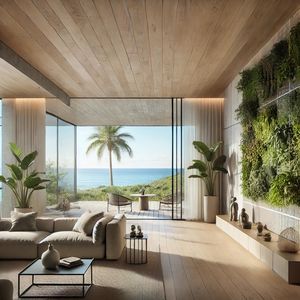
5. Statement Ceilings and Textured Walls
The days of plain white ceilings and flat walls are over. In 2025, homes are embracing bold statement ceilings with rich wood paneling, dynamic paint choices, or intricate molding. Textured walls, whether through plaster, wallpaper, or paneling, add depth and warmth, making every room feel intentional and curated.
Budget-Friendly Ideas for Flippers
For real estate investors and flippers, adding statement ceilings and textured walls can be an affordable way to increase perceived value and create a more custom feel. Some budget-friendly options include:
- Peel-and-Stick Wallpaper – A cost-effective way to add texture and depth to walls without committing to expensive finishes.
- DIY Ceiling Beams – Faux wood beams or lightweight materials can give the illusion of high-end craftsmanship at a fraction of the cost.
- Strategic Paint Choices – Using bold colors on the ceiling or creating geometric paint designs can provide an eye-catching feature without a hefty investment.
- Pre-Finished Wall Panels – Affordable wood or composite panels can be installed quickly and add an instant upgrade to interior spaces.
- Beadboard or Wainscoting – Classic wainscoting can elevate a room’s aesthetic at a relatively low cost, making homes feel more luxurious.
Luxury Considerations for Spec Home Builders
For high-end custom and spec home builders, statement ceilings and textured walls are about creating a sense of luxury and architectural refinement. Premium options include:
- Custom Wood Paneling – High-end homes are incorporating rich, natural wood treatments on ceilings to create depth and warmth.
- Hand-Troweled Plaster Walls – A premium touch that adds timeless elegance and unique texture to luxury interiors.
- Architectural Coffered Ceilings – These intricate ceiling details enhance the grandeur of a space, making it feel more expansive and sophisticated.
- Metallic or Venetian Plaster Finishes – Adds an upscale, polished look that creates depth and movement in the light.
- Textured Stone Accent Walls – A luxurious feature in living rooms and bathrooms that brings an organic, high-end feel to the home.
By tailoring ceiling and wall treatments to the budget and scale of a project, both investors and luxury builders can make a lasting impression on buyers, ensuring strong resale value and market appeal.
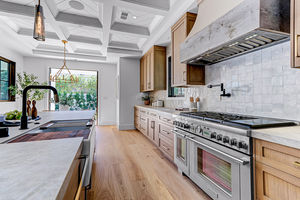 Our recent $5.6M sale of 1658 Ruhland in Manhattan Beach displayed a coffered ceiling
Our recent $5.6M sale of 1658 Ruhland in Manhattan Beach displayed a coffered ceiling
6. A Fusion of Vintage and Modern Lighting
Lighting sets the mood, and in 2025, homes are finding the perfect balance between old and new. Vintage chandeliers paired with sleek recessed lighting, or modern pendant fixtures with classic sconces, create an ambiance that is both timeless and cutting-edge. Lighting isn’t just functional—it’s a statement of style and sophistication.
Where to Find Vintage Lighting
For those looking to incorporate vintage lighting into their homes, some great sources include:
- Local Antique Shops & Flea Markets – Hidden gems can often be found at estate sales, vintage markets, or curated antique stores.
- Online Marketplaces – Websites like Chairish, 1stDibs, and Etsy offer a vast selection of restored and repurposed vintage lighting.
- Architectural Salvage Yards – Specialty salvage shops often carry historical lighting fixtures that add authentic charm to a space.
- Reproduction Lighting Stores – For those who want a vintage aesthetic with modern efficiency, brands like Rejuvenation and Schoolhouse Electric offer high-quality vintage-inspired fixtures.
Examples of Modern Lighting Trends
For a contemporary touch, modern lighting trends in 2025 emphasize:
- Minimalist LED Strip Lighting – Embedded into ceilings, walls, or under cabinetry for a sleek, futuristic look.
- Sculptural Statement Pieces – Oversized pendant lights or abstract chandeliers that double as artistic centerpieces.
- Mixed-Material Fixtures – Combining metal, glass, and natural elements like wood or rattan to add warmth and texture.
- Smart & Adaptive Lighting – Voice-activated and app-controlled lighting that adjusts brightness and color temperature for different moods and times of day.
By blending vintage charm with modern innovation, homeowners can create lighting schemes that feel both classic and forward-thinking, adding depth and personality to their interiors.
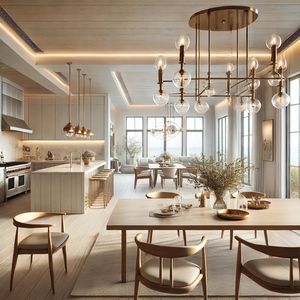
7. Flexible, Multifunctional Spaces
The way we live and work has changed, and home design is adapting accordingly. Remote work, entertaining, and family life all demand flexibility. Think home offices that seamlessly transition into guest spaces, kitchens designed for both cooking and conversation, and modular furniture that adapts to evolving needs. The best homes aren’t just beautiful—they’re built for real life.
The Rise of ADUs as Office Spaces
Accessory Dwelling Units (ADUs) are surging in popularity as homeowners seek additional, private workspaces. These detached or attached units provide a dedicated home office that is separate from the main house, allowing for increased productivity, privacy, and work-life balance. ADUs also offer versatility, doubling as guest suites or short-term rental spaces when not in use. Given Southern California’s focus on maximizing property value, well-designed ADUs with built-in office features are becoming a key selling point.
Casitas: A Luxury Trend in Multifunctional Living
For high-end buyers, casitas—detached guest houses with full amenities—are gaining traction as premium additions to luxury properties. These self-sufficient units provide additional living space for extended family, visiting guests, or even private wellness retreats. With increasing demand for flexible, multi-generational housing, casitas add both functional value and investment potential to properties.
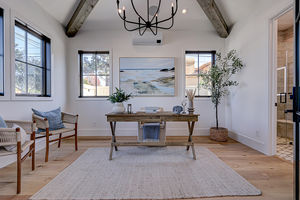 This floorplan with a detached casita is very popular in East Manhattan Beach.
This floorplan with a detached casita is very popular in East Manhattan Beach.
The Rise of Open, Conversational Kitchens
The kitchen has evolved into more than just a place to cook—it’s now the social heart of the home. Open-concept kitchens with large islands, integrated seating, and seamless flow into dining and living areas foster a conversational atmosphere. This trend is driven by a demand for more connected living spaces, where homeowners can entertain guests, keep an eye on family members, or enjoy casual dining experiences in a relaxed setting.
Budget-Friendly Ideas for Flippers
- Extended Counter Seating – A cost-effective way to make a kitchen feel more open and social.
- Pendant Lighting Over Islands – Enhances ambiance while defining the gathering space.
- Knocking Down Partial Walls – Even small structural adjustments can improve flow and create a more open feel.
- Multi-Functional Storage – Maximizing cabinetry with pull-out shelves and built-in organizers makes small kitchens more efficient.
Luxury Considerations for High-End Homes
- Oversized Kitchen Islands – Extra-large islands with waterfall-edge countertops offer ample prep space and double as a social hub.
- Professional-Grade Appliances – High-end homes feature chef-inspired kitchens with integrated smart technology.
- Seamless Indoor-Outdoor Flow – Large retractable glass doors that open directly to outdoor dining areas or patios blur the lines between indoor and outdoor living.
- Butler’s Pantries & Hidden Storage – Dedicated spaces for food prep, coffee bars, or wine storage add exclusivity and convenience.
By integrating ADUs, casitas, and conversational kitchens into home designs, both flippers and luxury developers can cater to the evolving needs of homeowners in 2025, ensuring maximum livability and long-term value.
For Flippers: What to Consider in Your Budget
For investors and flippers, these emerging trends should factor into renovation budgets to maximize resale value. Buyers in 2025 are prioritizing homes with sustainability features, flexible spaces, and timeless yet modern aesthetics. Consider allocating budget for:
- Sustainable Materials & Energy Efficiency – Fire-resistant materials, energy-efficient windows, and smart home integrations will make properties stand out.
- Curated Interiors – Statement ceilings, textured walls, and curved design elements provide an elevated, custom feel that commands higher resale prices.
- Biophilic Enhancements – Thoughtful landscaping, large windows for natural light, and indoor greenery add appeal and perceived value.
For Buyers & Sellers: What Brings the Best ROI in the SoCal Luxury Market
In the Southern California luxury market, buyers and sellers looking for the best return on investment should focus on:
- Location and Lifestyle Integration – Properties with ocean views, seamless indoor-outdoor living spaces, and wellness-driven amenities (such as home spas, meditation gardens, or fitness areas) are in demand.
- Smart & Sustainable Features – High-efficiency HVAC systems, solar panels, and smart home automation continue to be strong selling points.
- Timeless Design Choices – While trends evolve, certain design elements, such as neutral warm tones, open layouts, and custom craftsmanship, ensure long-term desirability.
The Klapper Group’s Take
At The Klapper Group, we believe a home should be more than just a place to live—it should inspire, protect, and adapt to the people who inhabit it. These emerging trends reflect a deeper shift in what homebuyers value: sustainability, functionality, and a design that aligns with their lifestyle. Whether you’re buying, selling, or investing in renovations, understanding these trends can help you make informed, forward-thinking decisions in 2025 and beyond.


